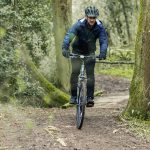Regardless of whether your bike has 10 miles or 10,000 miles under its wheels, we know as riders that there are always those little tweaks and changes that can help increase performance.
Below are some of the ways you can customise a new bike or breathe new life into one that’s already been put through its paces! Keep reading to discover some of the best bike upgrades that can help make a big difference.
Handlebar Grips
Your handlebar grips may seem like an insignificant part of the bike but, considering they’re the main way you can control your direction and feel what your front wheel is doing, it’s vitally important that they’re comfortable under your hands.
Most premium mountain bikes, such as the 2022 Voodoo range, come fitted with lock-on handlebar grips. These use a collar (or two) that can be tightened to hold them firmly in place, which makes them much easier to remove to replace for servicing or upgrade when compared to push-on grips. If you don’t already have lock-ons, they’re a must-have bike upgrade that offers a more reassuring feel.
Grips come in all shapes, sizes, and finishes, so knowing which one to choose can be tricky. Thicker grips can dull vibrations and while this will certainly help during long days on a bike over rocky terrain, it can make some riders feel less connected to the bike. Knurled grips will certainly help you to hold on but can become uncomfortable on sunny days when your gloves are left behind.
Nothing compares to testing grips on a ride! Ask a friend if you can borrow theirs (or swap if you’re riding together) and even if you don’t gel perfectly with them, it’s good to think about what you did or didn’t like to help you narrow down what you’re looking for.
Pedals
Want to ride more efficiently? Our pedal guide will break down how flat vs clipping pedals work and which is right for your setup.
Flat pedals are a great upgrade to your ride as they can help increase your performance and boost the overall look of your bike.
When choosing flat pedals, you want to keep an eye out for ones with metal pins. These pins help you position your foot correctly when riding and keep you planted to the pedal much more efficiently than other pedal types. Flat pedals also allow your feet more freedom and give you the ability to put your foot out if you feel yourself starting to fall (not that this ever happens to you, right?!)
One downside to flat pedals is that the pins can tear through trainers at a quicker rate than you’re probably used to, so it’s always advisable to buy specific mountain bike shoes.
Flat pedals aren’t your only choice. There are also clipless pedals or ‘clipping pedals’ such as Shimano SPDs, which allow you to clip into the pedal. (Yes, the name’s confusing – it refers to pedals that ditch toe clips and straps!)
You’ll need a specific pair of shoes when you buy SPD pedals as they’ll come with cleats that attach to the sole of the shoe and then attach the shoe to the pedal.
A key advantage of SPD clipping pedals is that you don’t lose any power as you rotate the cranks because your foot is always attached to the pedal, which improves your overall cadence. The downsides to SPDs versus flat pedals are price and ease of use. Buying SPD pedals and shoes to match usually costs a bit more than flats, while the process of clipping into the pedals can take time to get used to and is a more difficult skill to learn.
Ultimately the choice is yours – just get riding!
Saddle
If your bike isn’t comfortable, you aren’t going to ride it. That’s something we all know and a sure-fire way to increase comfort is with a well-made saddle.
Good bikes will come with decent saddles that are a great fit for a lot of people, but there are a number of different saddle brands, designs and feels out there that ultimately might suit you and your style of riding better.
If you haven’t ridden a bike before or in a long time, then you may notice some discomfort. This is totally normal and it’s simply your body adjusting to riding (it’s a bit like going to the gym for the first time!).
However, if you’re still experiencing discomfort after 3 of 4 weeks or riding then it may be time to explore other avenues. Alongside a new saddle, you may want to consider getting a professional saddle fitted as this will allow you to understand the perfect size and design for you. Lastly you should consider a quality pair of padded cycling shorts, as these are ideal for taking pressure off your sensitive areas.
Dropper post
Dropper posts (or droppers) have quickly become a must- have accessory for every trail rider. Quick release seat posts are great for making quick stationary adjustments, but what if you want to make a change while you’re riding? That is where a dropper post comes in.
A dropper gives you the ability to ‘drop’ your saddle and then raise it again – an action that’s controlled by a lever on your handlebars. The level of adjustability makes the world of difference to your ride. If you’re descending, drop the saddle out of your way and move your weight around to give more stability. Then, as soon as you hit a climb, raise that saddle and get those efficient pedal strokes working.
Tyres
An easy way to upgrade your bike is to get some new bike tyres. Depending on the time of year and where you are riding, there are a multitude of different options that are all aimed at improving the way your bike handles.
If you’re riding trails, look for tubeless-ready as these will allow you to run at lower pressures and give you more grip. The Schwalbe Hans Dampf or Schwalbe Magic Mary, for example, have been designed specifically for speed and grip when riding downhill and are an easy upgrade.
Tubeless
A quick upgrade, but one that’s really worth it if you want to stop punctures ruining your day!
Tubeless, as the name suggests, means running your bike without inner tubes. Some bikes will need new tubeless-ready tyres (such as the Schwalbe’s mentioned above) along with rim tape and sealant and valves. For others, it’s as simple as just adding the sealant.
One of the main benefits of going tubeless is they can typically plug or self-seal any 3-5mm holes, allowing you to carry on riding. They’re also lighter than using a tube set up and you can run at a lower pressure, giving you more grip but at the same time ensuring you won’t get pinch flats!
A CO2 inflator is one final great addition to your kit when you’re running tubeless. It’s an easy way to reinflate your tyre if you’ve had a puncture that’s sealed itself or burped some air.
And that concludes our top bike upgrades that can easily make a big difference to your cycling adventures. You can explore our wide range of cycling accessories online or speak to one of our friendly experts in-store for further recommendations.

